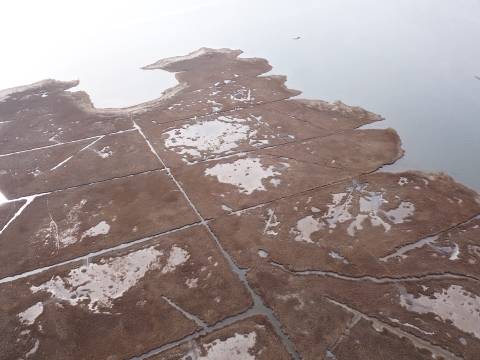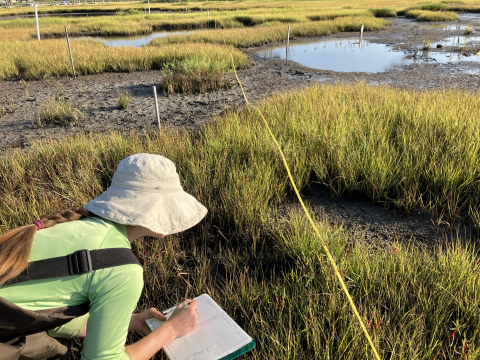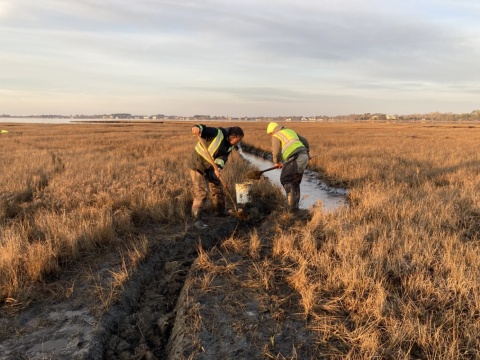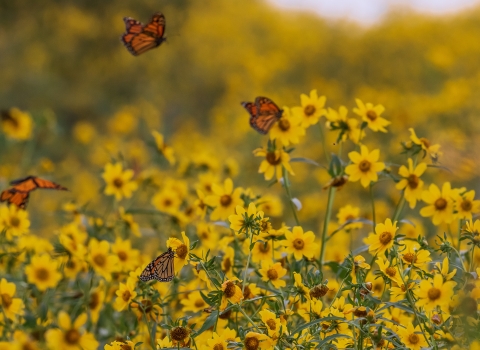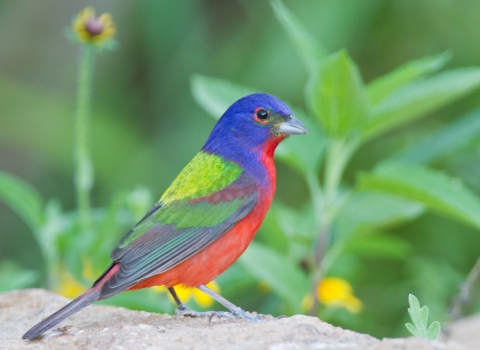Areas along the Atlantic Coast where the ocean meets the land, a unique ecosystem exists consisting of a mosaic of grassland, mud flats and channels – the salt marsh salt marsh
Salt marshes are found in tidal areas near the coast, where freshwater mixes with saltwater.
Learn more about salt marsh . Flooded and drained twice daily with the tides, a salt marsh is home to unique, native wildlife that live nowhere else. Many birds, fish and other wildlife rely on salt marshes, including most commercial and recreational aquatic life that support a multi-billion-dollar industry. Salt marshes are important for people too, buffering coastal communities and infrastructure from flooding due to intensifying storms.
Many salt marshes are disappearing due to development and climate change climate change
Climate change includes both global warming driven by human-induced emissions of greenhouse gases and the resulting large-scale shifts in weather patterns. Though there have been previous periods of climatic change, since the mid-20th century humans have had an unprecedented impact on Earth's climate system and caused change on a global scale.
Learn more about climate change , and over the last decade the United States has led the world in rates of salt marsh loss. Despite significant losses in salt marsh habitat, there are bright spots: biologists and other scientists are developing successful techniques to restore degraded marshes and protect marsh-migration pathways in adjacent uplands to protecting our coastlines for people and wildlife.
The Chesapeake Bay Field Office has embarked on the Maryland Coastal Bays Marsh Restoration effort to restore salt marshes; monitor the techniques used to ensure future success and educate coastal communities about the importance of salt marshes and ways they can participate restoration. Partners include Maryland Coastal Bays Program, University of Maryland College Park, University of Maryland Center for Environmental Sciences, Maryland Department of Natural Resources, Maryland Department of Agriculture, and Western Maryland Resource Conservation and Development Council.
The Rum Pointe Marsh Restoration Project seeks to identify causes of and solutions to megapool formations across salt marshes on the East Coast. Megapools are large impoundments of water present in altered or ditched salt marshes. As these megapools continue to expand, salt marsh plants disappear eventually turning healthy ecosystems into barren flats.
Pre-Construction Monitoring
Because megapool formation is relatively new, little is known about the biogeochemical changes that occur in the marsh to establish these pools. Additionally, there is curiosity surrounding why pools appear in some places but not others. To explore this question, extensive pre-construction monitoring was done on water, soil, elevation, vegetation, and sulfides to explore how fully formed megapools differed from partially formed or unformed areas. At the Rum Pointe Marsh Restoration site in Berlin, MD, monitoring occurred in August of 2021 and 2022. Initial results found that megapools had higher sulfide levels and lower elevation, plant biomass, and carbon bulk density than vegetated marsh. These findings implicate soil water logging and sulfide, a phytotoxin, as causes of plant dieback, and suggest that restoration techniques should focus on reducing impoundment of water such as runnels.
Restoration
In January of 2023, 40 runnels, small, winding channels no deeper or wider than 12 inches, were installed across the 35-acre Rum Pointe Marsh site. These runnels reconnect megapools with the natural tidal movements. Putting in these runnels should not only reduce the water logging in megapools but enhance native plant growth. While there are other large scale restoration techniques, such as thin layer placement, runnels represent a great option due to the relative low cost and ease of implementation - making them an excellent tool for working on private land.
Post Construction Monitoring
To determine success of various restoration techniques, pre and post construction monitoring is necessary. Many of the same variables collected before construction are being collected after construction too. The 1st year post construction monitoring was completed in August 2023 assessing vegetation regrowth, success of plantings, amount of mosquito larvae, water levels, and land elevations.
Education
In Partnership with Audubon Mid-Atlantic, Maryland Coastal Bays Program, and Lower Shore Land Trust, two workshops were designed for salt marsh landowners to learn about restoration solutions. Those with land within the priority areas for saltmarsh sparrows, a bird at-risk or becoming threatened or endangered or black rails, a bird already identified as threatened, were also invited. The workshops occurred in the Spring of 2023 at local libraries in Belin, MD and Snow Hill, MD. The topics included current local salt marsh efforts, restoration opportunities, monitoring techniques, and land conservation options. Landowners had the opportunity to voice concerns about loss of salt marshes and restorations efforts, changes they have seen on their own land and support they need from organizations and agencies.
Looking Forward
The Chesapeake Bay Field Office and partners will continue monitoring the success of Rum Pointe Marsh Restoration Project, and work to restore three additional projects in Snow Hill, MD in the Fall of 2024. Baseline monitoring occurred in August of 2023. These sites were also surveyed for nekton (fish and other organisms that actively swim). Based on the work completed at Rum Pointe, a monitoring assessment for salt marsh restoration will be used at these sites. These three projects will use runnels as well as other low tech marsh restoration techniques such as strategic ditch fill and cleaning. Four other projects located across the Maryland Coastal Bays are in the design phase now with anticipated construction in 2026. In addition, using the information expressed by landowners at the previous workshop, new workshops are planned to help coastal communities understand what is happening to the salt marshes, what can be done to restore and protect them, and how individuals can get involved.

